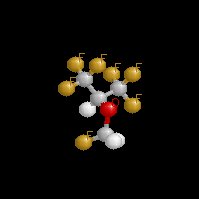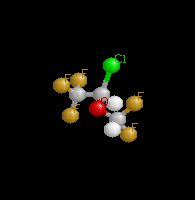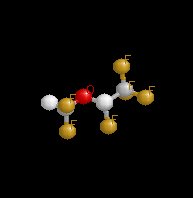Anesthesia Pharmacology: Physics and Anesthesiology
Example #3: In this example we again only know the vapor pressure at two different temperatures and want to find the heat of vaporization. We'll pick the anesthetic agent enflurane (Ethrane). The vapor pressure at 20 degrees C. is 175 mm Hg and the vapor pressure at 36 degrees C. is 345 mm Hg. We would begin again with the Clausius-Clapeyron equation:
Again as above, R = 8.31 x 10-3 kJ/mole K
ln(P2/P1)
= -![]() Hvap
/R *(1/T2-1/T1),
rearranging
Hvap
/R *(1/T2-1/T1),
rearranging
ln(345 mm Hg/175 mm Hg) = [-![]() Hvap
/8.31 x 10-3 kJ/mole K] *(1/309oK-1/293oK)
Hvap
/8.31 x 10-3 kJ/mole K] *(1/309oK-1/293oK)
ln(345/175)*8.31 x 10-3
kJ/mole K /(1/309oK-1/293oK)
= -![]() Hvap
OR
Hvap
OR
(0.679*0.00831
kJ/mole oK)/-1.77 x 10 -4oK = -![]() Hvap
Hvap
31.87 kJ/mole
= -![]() Hvap
Hvap
![]()
Example #4: In this case the anesthetic agent is desflurane (Suprane). The vapor pressure at 20 degrees C. is 669 mm Hg, whereas the vapor pressure at 22 degrees C is 731 mm Hg. Using the method above:
R = 8.31 x 10-3 kJ/mole K
ln(P2/P1)
= -![]() Hvap
/R *(1/T2-1/T1),
rearranging
Hvap
/R *(1/T2-1/T1),
rearranging
ln(731 mm Hg/669 mm Hg) = [-![]() Hvap
/8.31 x 10-3 kJ/mole K] *(1/295oK-1/293oK)
Hvap
/8.31 x 10-3 kJ/mole K] *(1/295oK-1/293oK)
ln(731/669)*8.31 x 10-3
kJ/mole K /(1/295oK-1/293oK)
= -![]() Hvap
OR
Hvap
OR
(0.089*0.00831
kJ/mole oK)/-2.31
x10-5K = -![]() Hvap
Hvap
32 kJ/mole
= -![]() Hvap
Hvap
![]()
Anesthetics, Physics, and Putting Some Things Together
4 Consider the following pricing for different anesthetic agents: sevoflurane (Sevorane, Ultane) -- $178/250 ml bottle; isoflurane (Forane)-- $23/100 ml bottle; desflurane (Suprane) -- $73/250 ml bottle. Other Information:
Sevoflurane (Sevorane, Ultane):
Molecular weight = 200.05
Blood/gas partition coefficient: 0.65 (37 oC.)
Boiling point: 58.6 oC.
Vapor pressure: 157 mm Hg at 20oC.
Specific gravity at 20oC = 1.52-1.525; [the specific gravity by definition is the density of the substance divided by the density of water which is 1 g/cm3]; therefore the density of sevoflurane (Sevorane, Ultane) = 1.52 g/ml
MAC: 1.8% [37 oC, 30-55 years old, ambient pressure: 760 mm mercury]

Halothane (Fluothane)
Molecular weight = 197
Blood/gas partition coefficient: 2.54
Boiling point: 50.2 oC at 760 mm Hg
Vapor pressure: 243 mm Hg at 20oC.& 760 mm Hg
Density: 1.86 g/ml (20 oC)
MAC: 0.75% [37 oC, 30-55 years old, ambient pressure: 760 mm mercury]
Enflurane (Ethrane)
Molecular weight = 184.5
Blood/gas partition coefficient: 1.90
Boiling point: 56.5 oC
Vapor pressure: 175 mm Hg at 20oC.& 760 mm Hg
Density: 1.52 g/ml (20 oC)
MAC: 1.63% [37 oC, 30-55 years old, ambient pressure: 760 mm mercury]
Isoflurane (Forane):
Molecular weight = 184.5
Blood/gas partition coefficient: 1.46
Boiling point: 48.5 oC
Vapor pressure: 240 mm Hg at 20oC.& 760 mm Hg
Density: 1.50 g/ml (20 oC)
MAC: 1.17% [37 oC, 30-55 years old, ambient pressure: 760 mm mercury]

Desflurane (Suprane):
Molecular weight = 168
Blood/gas partition coefficient: 0.42
Boiling point: 22.8 oC
Vapor pressure: 669 mm Hg at 20oC.& 760 mm Hg
Density: 1.45 g/ml (20 oC)
MAC: 6.6% [37 oC, 30-55 years old, ambient pressure: 760 mm mercury]
6Generally, for the inhalational agents the vapor pressure is typically below atmospheric pressure (at 20oC).
The vapor pressure increases with increasing temperature is the basis for the need to provide heat in support of vaporization.
Desflurane (Suprane) is some of the special case because it has a boiling point of 23.5 oC and therefore it will boil at room temperature.
By definition, a liquid's boiling point is the temperature and which its vapor pressure is greater than atmospheric pressure when the container is open to the atmosphere.
When this temperature is exceeded, molecules convert to the gas phase within the liquid and boiling is observed.
Because of the special circumstance with desflurane (Suprane), the special containers used to insure that transfer of desflurane (Suprane) from its bottle to the vaporizer can occur without atmospheric exposure.

![]()
3Example #5: The problem is how to determine the cost of administration of an anesthetic gas.
As we will see, a number factors will influence the cost; however, we will initially focused on sevoflurane (Sevorane, Ultane) which we will say has a cost of about $178/250 ml bottle or $0.71/cc.
Furthermore, the average administration will be 1% anesthetic [MAC for sevoflurane (Sevorane, Ultane) is about 1.8%] and the fresh gas flow (diluent) is 5 l/minute.
The last thing we need to consider in this approximation is that the operating room temperature will be considered to be about 20 oC.
Firstly, we need to find out the number of liquid ccs (mls) that will be used per minute. Noting from above that density of sevoflurane (Sevorane, Ultane) is about 1.52 g/cc at 20 oC.
Secondly, we need to know the molecular weight for sevoflurane (Sevorane, Ultane) which is 200. 1 mole would have a molecular weight of 200 grams.
(1.52 g/cc) / 200 g/mole = (1.52 /cc) / (200 /mole) =0.0076 moles/cc
We know from earlier that at standard temperature and pressure one mole of a vaporized liquid will be equal to 22.4 l of gas. So, 22.4 L/ 1 mole = X L/ 0.0076 moles with X = 0.1702 L of pure sevoflurane vapor per cc. Now this is for 100 % sevoflurane vapor. To get our 1% value we need to dilute by a factor of 100 (1% is 1 part per 100); so 1% sevoflurane would occupy 17.02 L (mixed with O2)
Now with an O2 flow rate of 5 L / min and given that 1 cc provides 17.02 L at 1%, then the system will use up 5L/min/17.2L or about 0.29 cc of sevoflurane/min. The cost was $0.71/cc so it costs $0.20/per min or about $12.35/hour.
5Actually, a number of factors contributed to the cost beyond that which we considered above. We basically looked at the cost of the anesthetic, made an assumption about the average requirement (in terms of % anesthetic) and set a certain overall delivery flow rate (diluent at 5L/min). Although the actual procurement cost (price) is important, other factors having to do with the anesthetic properties itself are also important. These factors include vapor pressure, potency, and solubility. Clearly delivery flow rate would be important. Low flow rates tend to decrease cost and certain less-soluble anesthetics are amenable to reduce flow rates.
![]()
3Example #6: Let's suppose that you are carrying a bottle of sevoflurane (Sevorane, Ultane), which contains 250cc of pure liquid.
In the operating room you drop the bottle and it breaks. Should you be concerned that the operating room personnel will be anesthetized as a result of liberation of this quantity of sevoflurane (Sevorane, Ultane)?
To solve this problem, we utilize a result from the previous example in which it was calculated that 1cc sevoflurane (Sevorane, Ultane) would correspond to 0.1702 L of pure sevoflurane (Sevorane, Ultane) vapor. Since 250 cc of sevoflurane (Sevorane, Ultane) was liberated, multiply 0.1702L/cc by 250 cc to get the amount of pure sevoflurane (Sevorane, Ultane) vapor actually released. The result is about 42L.
So, as a result of our dropping the bottle we have released 42L of pure sevoflurane (Sevorane, Ultane) vapor into the operating room.
The extent to which the 42L will be diluted is based on the volume of the operating room.
Suppose the operating room dimensions are 7x8x4 m, resulting in a volume of 224 m3. [1000 cc = 1 L; 100 cm/m so 100 cm x 100 cm x 100 cm = 1,000,000 cc = 1 m3 = 1000 L]. Therefore, 224m3 would be equal to 224,000 L.
This large number is the dilution factor and following complete mixing, the highest "equilibrium" concentration would be 42L/224,000 L =0.00019 or 0.019% which is far less than required for anesthesia.
Two additional points need to be made of course.
Firstly, the concentration would be considerably higher in the immediate vicinity of the spill before substantial mixing could occur.
Secondly, the operating room is actively ventilated usually insuring at least 10 complete air changes per hour.
As a consequence, the washout of the sevoflurane (Sevorane, Ultane) vapor would occur very rapidly as a result of dilution due to ventilation.
![]()
3Example #7: In this problem you have to take a mechanically ventilated patient from the intensive care setting to obtain an MRI.
You leave the ICU within oxygen tank (E cylinder, which has a volume of 4.4L) which is pressurized to 2200 psi and starts out full.
The fresh gas flow is set to 8.2L/minute and it takes you 20 minutes to transport the patient to the MR.
The gas cylinder of course is left outside the room with the superconducting magnet; however, unfortunately, the cylinder valve was not closed and gas remained flowing at 8.2 L/minute.
The patient is in the scanner for about 90 minutes due to the number of scans requested and because the patient moved requiring certain scans to be repeated.
You discover the valve problem when it's time to take the patient back to the ICU and of course the question is is there enough oxygen remaining to support transport back?
The first important relationship to consider is: P1 x V1 = P2 x V2 where P1 is equal to the initial tank pressure and V1 is equal to the tank volume.
We also know P2 which is 1 atm or 14.7 psi. (2200 psi x 4.4 L) / 14.7 psi = 658 L.
So, V2 = 658 L at 0oC which corresponds to 658L * 293oK/273oK or 706 L, which is the volume that must last long enough to get back.
Our flow rate was 8.2L/min. so using 706 L we have 706 L / 8.2 L/min = 86 minutes.
Unfortunately the oxygen supply ran out while the patient was still in the scanner.
1Basic Physics and Measurement in Anaesthesia, Davis, P.D., Parbrook, G.D. and Kenny G.N.C, 4th Edition, Butterworth Heinemann, pp 50-51, 1995.
2Basic Physics and Measurement in Anaesthesia, Davis, P.D., Parbrook, G.D. and Kenny G.N.C, 4th Edition, Butterworth Heinemann, pp 54-55, 1995.
3Practical Anesthesia Physics: Part 1: Airway & Vaporizer, Rampil,I., 1995
4 University of Alabama Anesthesiology Department (R. G. Ritchie, Ph.D. & P. M. Desai, M.D.
5Pharmacology and Physiology in Anesthetic Practice, Stoelting, R.K., 3rd edition, Lippincott-Raven, Philadelphia, 1999, pp 36-37.
6Ebert, T. J. and Schmid III, P. G. "Inhalation Anesthesia" Ch. 15 in Clinical Anesthesia (Barash, P.G., Cullen, B. F., and Stoelting. R.K., eds) 4th Edition, Lippincott Williams& Wilkins, Philadelphia, pp. 377-387, 2001